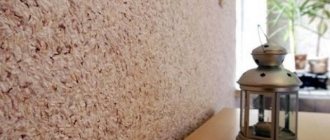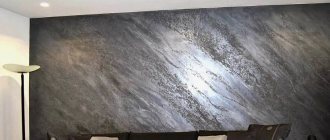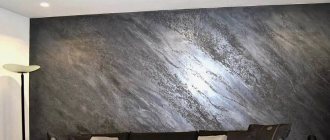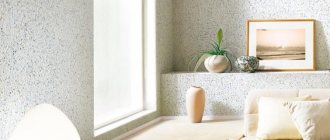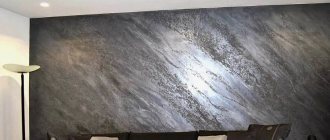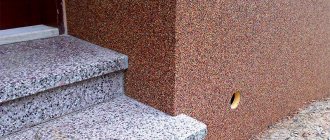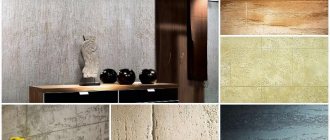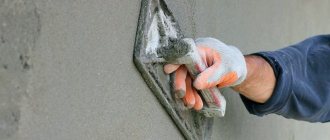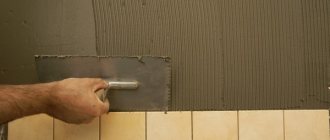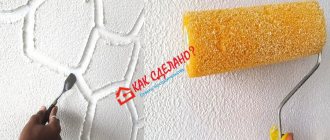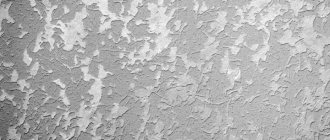Types of silk decorative plasters
One of the most sophisticated modern coatings is considered to be a coating that imitates a silk surface. If you look at it from different angles, you can observe a fantastic play of light, thanks to the mother-of-pearl fillers. Different designs create the illusion of translucency of the walls. All these effects are achieved by finishing the wall surface with a unique material - silk decorative plaster.
This miracle appeared on the building materials market in the 90s of the last century. Such plasters were imported from France, Turkey and even Japan. It was one of the most expensive and prestigious materials. However, something inexplicable happened. The demand for silk decorative plasters is not very high
This is because wealthier buyers were already fed up with this type of wall decoration and switched to newer ones, while less wealthy buyers did not dare to pay attention to this material, still believing that it was expensive. Although foreign manufacturers have long ago lowered the price level to $13 per 1 kg of the mixture, domestic manufacturers have long mastered the technology of its production and sell silk decorative plaster even cheaper - from $3 to $16 per 1 kg
Plasters of this type with the addition of artificial silk are widely represented on the building materials market by fairly well-known companies:
- "SILKOT" Japan;
- "Senedeco" France;
- "BAYRAMLAR" and "SILKOAT" Türkiye;
- “RODNIK-ART” and “PEACE TO YOUR HOME” Russia.
Silk plaster with artificial silk comes in different textures and compositions. Depending on these indicators, its price is calculated. It ranges from $2.5 to $25 per package, which can be used to plaster from 3m2 to 5m2.
Plasters with the addition of natural silk fibers are presented on the building materials market:
- FUDZIVARA CHEMICAL Co. Japan. These are 14 types of decorative silk plaster made in several colors. Such plasters are now quite rarely found on our market;
- "BAYRAMLAR" Türkiye. All wet silk decorative plasters produced by this company contain natural silk additives. Of course, this influences their high price points;
- “PEACE TO YOUR HOME” Russia. This manufacturer’s product range also includes one type of plaster with the addition of natural silk. The cost of one package of such plaster is about $9.
Manufacturers
Decorative plaster “wet silk” appeared on sale at the end of the last century. At first it was made in France and Turkey, and after that production gradually began to expand, and the trend was picked up by many other European countries.
Today the situation has changed, but only slightly. Richer people could afford to buy real materials for decoration, and not imitation ones. People with a more modest budget paid attention to simpler options. Venetian plasters remained in the mid-price segment thanks to good advertising. Now decorative plaster is produced even in Russia, so there is a choice among manufacturers.
The following manufacturers are popular on the market:
- VGT;
- Senideco;
- Derufa.
There are also small intermediary manufacturers who have a personal brand and many advantages. You need to take proven materials that are produced by well-established companies. These three are now highly valued in the market.
Attention
The price of wet silk is significant, but you won’t have to worry about the quality and pay double the amount to correct composition errors.
What is the material
There is a misconception that silk plaster and liquid wallpaper are the same material. This confusion is due to several reasons.
Firstly, both products can create a “silk” surface. But this is achieved in different ways. Thus, liquid wallpaper contains the main components in the form of silk or cellulose fibers. It is the components that ensure the desired result. Plaster acquires the desired effect due to the application technique.
Secondly, some manufacturers indicate that the plaster contains cellulose threads and silk particles. Yes, such substances are included in decorative mixtures, but they are not the main components, their content is insignificant.
In fact, silk decorative plaster includes particles of mother-of-pearl that have reflective capabilities (the rest of the components are standard). They are the ones who create overflows. To achieve this result, it is necessary to apply very thin layers, each of which will be no more than one millimeter. It should be noted that the number of layers can be from two to eight.
Coating textures
Silk plaster can be of different textures and densities, it depends on the density of the coating, the method of its application, as well as the characteristics of the composition and consistency. The coating can be quite smooth or velvety. In the first case, the plaster contains thin threads, dyes and metal pigments. The pattern acquires a voluminous effect due to inclusions of mother-of-pearl, which sparkle and shimmer on the walls. Unlike liquid wallpaper, silk plaster is created from astringent acrylic polymers, as well as polyester fibers and quartz chips.
The most important ingredients are cotton threads and cellulose. Plasticizers extend the life of the mixture.
Advantages and disadvantages
Decorative plaster has a lot of positive properties:
- Environmental friendliness. The material does not contain harmful substances that may have a negative impact on human health.
- Fire resistance. The mixture is not subject to combustion, therefore it is not a fire spreader. It also does not release toxic components when heated.
- Durability. The service life of such coating is tens of years. Excellent resistance to mechanical stress.
- Possibility of application to any surface. Indeed, the solution can be laid on different types of substrates.
It should be noted that there are also some disadvantages:
- High price. If we assume that lining 7 square meters (using a roller) requires 1 kg of mixture, then taking into account the number of layers it is not difficult to calculate the consumption and the final price.
- Difficulty performing the work. To get a truly amazing result you will have to make an effort. But this is a drawback of all decorative solutions.
- Difficulties of restoration. In fact, repairing a damaged area is quite simple, but the difficulty is that it is almost impossible to restore the desired effect. Especially if the coating has patterns or designs.
Where to order and buy?
This type of finishing is expensive: 1 square meter - from 600 to 950 rubles (depending on the brand and type of silk). The price of the material will be about 120–500 rubles for covering 1 sq. m. meter of wall. But you will get the effect of iridescent silk.
You can order wet plaster directly from the manufacturer by phone or through an online delivery service. If you're lucky, you can find the color you need at the nearest chain store to avoid overpayments for delivery.
Wet silk began to be actively used in interior design of ceilings and walls of all types of premises. This is due to the good characteristics of the composition, its durability, and practicality. Application is simple: even an inexperienced plasterer or painter can easily handle it.
Composition of plaster, areas of its application
Silk decorative plaster is used on fairly smooth surfaces; small defects are acceptable: the material is plastic, so it can hide minor cracks or smooth out curvature.
Noble decoration is appropriate both in an apartment or private house, and in official institutions. The coating will complement an elegant, strict or bold extravagant interior - its appearance depends on the components.
Silk plaster includes quartz chips to form a special structure. Among the producers of such finishing materials, French and Italian factories are the leaders - this is a product in a more expensive segment. The quality of goods from Turkey and products of some domestic brands is quite acceptable.
Each consumer can choose a dry or moistened type of material. The dry type will be convenient for moving and storing. It is preferred by those who are not sure about the timing of the start of repairs.
Wet silk decorative plaster is made with your own hands from liquid and dry components, which must be mixed according to the instructions. A rich color palette, special types - for example, with the addition of glitter or crumbs - will allow any consumer to choose the right option.
Required Tools
Decorative silk plaster can be applied in different ways. Depending on its type, as well as the method of application, various special tools are needed. This section describes the equipment that will be useful to the master in any case; the special tool will be indicated later.
List of required tools:
- Spatulas with rounded edges - these spatulas do not leave grooves;
- Venetian trowel. Depending on the surface area and desired pattern, the sizes of the trowels will vary;
- Roller;
- Containers for solution;
- Drill and mixing attachment. This tool is only needed when working with large volumes.
Accessories:
- Gloves;
- Respirator;
- Covering material;
- Bucket for water;
- Rags;
- Protective glasses;
- Masking tape.
You can do without some of the above when working with a composition such as silk plaster. Having all this will not only help you with your work, but will also ensure your safety.
Application of decorative plaster
For application you will need the following tools and materials:
- Plaster is sold ready-made. Additionally, you can purchase colors.
- Trowel.
- Putty knife.
- Roller.
The technological process is as follows:
- The first layer is the base one; it will serve as the basis for further activities. It is applied in a thin layer. The work is done using a spatula and trowel. The mixture is collected in the required quantity and placed on a trowel. The tool is applied to the surface at a slight angle, movements should be smooth.
- The resulting surface is left for several hours. It should dry out enough. The exact timing indicators must be clarified in the manufacturer's instructions.
- The second layer is applied in the same order. But it must not be allowed to dry out, so the relief is formed immediately. The trowel is used to perform arc movements that create the required pattern. It is slightly smoothed.
Roller usage:
- The base layer is applied in the same way as in the first case.
- The subsequent layer is applied using a roller with a short question. They cover the required area. The mixture is laid without flaws, completely filling the selected space.
- Next, a trowel is used. They literally smooth the surface. The selected texture is formed with jerky movements.
Do not use a long-haired roller. It leaves behind a thick layer of material that is very difficult to process.
Creating a “velvet” surface
The work is carried out according to the following principle:
- The solution is applied in a layer that should not be too thin. This is because everything will be done in one step. The trowel must be used to make random strokes.
- Next, the necessary invoice is formed. The trowel is passed over the coating; movements should be jerky, without excessive pressure.
- The removed mixture will remain on the instrument. It is removed with a spatula.
- The entire area is processed, after which it is left until completely dry.
To get the result that was intended, you need to practice a little. The main thing is to understand the specifics of formation.
Crinkled silk effect technology description
The described decorative plaster allows you to create the effect of crushed silk on the wall. As with the previous effect, the entire process from preparation to creation of the coating will be similar. There is no point in describing it, just briefly recall the stages.
- Preparing the walls.
- Preparation of the mixture.
- Base layer.
- Crinkled silk - the effect is achieved using a sponge. Apply the composition and when it dries a little, apply a sponge, which will create the effect of crumpled fabric.
Advantages and disadvantages of wet silk coating
Like all decorative coatings, wet silk plaster has its pros and cons. As usual, let's start with the positive characteristics.
- Stylish design. The rich appearance of the coating with a mother-of-pearl sheen truly looks luxurious and unique.
- Possibility to choose any coating color down to the smallest shades. You can tint the material either yourself, manually using tinting paints, or automatically, which is more preferable to obtain a high-quality result.
- This is a seamless coating, which, unlike wallpapering walls, does not have unsightly joints.
- Can be used in any room, as the coating is environmentally friendly and waterproof.
- The wet silk coating is easy to keep clean - it can even be washed with a wet sponge, while the preservation of the original appearance is guaranteed by the manufacturers. It also allows the use of household chemicals and even solvents.
- If necessary, you can easily make minor repairs to individual surface fragments.
- Durability - manufacturers guarantee 20 years of impeccable service life.
Another advantage is attributed to this coating - ease of application, which, according to the manufacturers, can be done even by a novice repairman without experience. But it is not so. If you want to get a really high-quality result that will please you for many years, then it is better to invite a professional to apply the plaster.
Also, as an unreliable advantage, it is necessary to mention the absence of the need to prepare the surface for applying decorative plaster. Some resources convince us that there is no need to level the walls, eliminate potholes, cracks and chipped surfaces. However, this is also a very big misconception. It is always necessary to level the walls, and in our case this must be done with special care. After all, a perfectly flat wall is the key to a high-quality result.
The disadvantages include the high cost of this type of coating and the requirements for a perfectly flat base, which we just talked about. That's all. Instability to moisture, which is also often attributed to disadvantages, is not such, and the coating perfectly resists even direct exposure to moisture. Let us remind you that walls with this plaster can be washed with a wet sponge.
Caring for decorative coating
Caring for decorative coatings is not a difficult task. Dust is very easy to remove with a regular vacuum cleaner; don’t be afraid, nothing bad will happen to the coating during the cleaning process. Wet cleaning is also not a problem; the wall can be wiped with a damp cloth. For severe contamination, use a soap solution or non-aggressive household chemicals.
Remember the cycle of complete readiness of the coating for use is usually 21 days
If the structure was damaged during operation, simply take the same mixture and edit the drawing.
Some nuances
This material is very demanding on surface preparation. Although it can hide small cracks, other defects will be noticeable. Therefore, it is necessary to eliminate any shortcomings.
It is worth paying attention to some features:
- Avoid using products called fiberglass. It can damage the decorative layer. This is due to the fact that the material has good absorbency, which even a primer cannot level out.
- If metal beacons were used to apply the starting composition, they must be removed. Otherwise, there is a high probability that traces of corrosion will form.
- Walls in rooms characterized by high humidity are treated with moisture-resistant impregnations. Antiseptics are applied in advance, which should protect against fungus and mold.
Many manufacturers of silk-effect plaster recommend observing certain time intervals. Namely:
- block walls must withstand an interval of several months after the starting coating has been applied;
- for brick walls the period is up to six months;
- if the work was carried out in winter (in frozen rooms), then the decorative layer is laid only in summer.
Negative qualities of the material
One has only to look at the photo of silk plaster, where everything is extremely clear and understandable that the material gives an excellent appearance to the interior! However, it also has disadvantages:
- Expensiveness of the material. At the same time, there are more inexpensive options that use artificial fiber.
- Good moisture absorption property, which is why the material is not suitable for bathrooms and other rooms with high humidity levels.
- The ability to absorb odors, which makes the material not suitable for kitchens and toilets.
Creating the effect of silk threads
“Silk threads” is a technique for applying decorative plaster, with the help of which a relief coating is obtained with long and thin vertical stripes across the entire surface. To create it, use the same acrylic plaster that is used for the “wet silk” coating.
For work you will need: the same tools + a decorating brush or a brush with stiff bristles.
Application technique:
- Prepare the base, apply a primer and leave until completely dry (12 hours).
- Cover the prepared surfaces with 1-2 layers of interior paint. Thanks to this, the hardening time of the plaster will increase, which will allow high-quality “threads” to be formed on the surface. Allow at least 2 hours between coats to allow the paint to dry.
- Acrylic plaster is thoroughly mixed and poured into a cuvette.
- The composition is applied using a fur paint roller. Layer thickness – up to 1 mm. If applied evenly, each square meter will require about 500 g of plaster. If they work alone and the surface area is large, treat 1 m² areas sequentially.
- While the material is not dry, use a plastic decorative brush to form the necessary relief. To do this, apply a brush to a wall covered with plaster, move it up and down, creating long vertical stripes.
- Before the solution hardens, you need to smooth the surface with a plastic spatula. During the process, excess composition will collect on its working edge; it must be removed with a clean rag.
- After the desired relief has been created on the surface, it is left to dry for 24 hours.
- Proceed to creating the finishing layer. Apply decorative varnish using a paint roller. While it is still wet, remove excess with a Venetian trowel. The pearlescent pigment penetrates into the recesses and is almost wiped off from the smooth surface, emphasizing the relief and enhancing the decorative effect. The varnish dries within 24 hours.
How to make “silk threads” in the interior yourself is shown in the next master class.
Silk-like decorative plaster is an elegant coating that is practical. Using various techniques, you can use it to decorate the walls of your kitchen, bedroom or living room in an original and stylish way.
Previous Decorative plaster “American” - a quick way of decorative plastering Next Decorative plaster Shagreen from plaster: cheap and quick wall finishing
Varieties and characteristics
Initially, decorative plaster was popular in Venice, hence the name Venetian. Since then, it has been valued by the most discerning admirers of originality and chic. The glossy surface, so clearly reminiscent of marble, as well as a huge range of color palettes and unique patterns will transform the most ordinary room. Real marble is something that many people want, but not everyone can afford.
Today in the world there are thousands of varieties of plasters, which differ in the size of the grain of marble chips, the presence of sand and synthetic ingredients in its composition.
Any finish is designed, first of all, to satisfy design requirements, so the most convenient for the consumer is its classification according to the nature of the visual effect. From this point of view, decorative plaster is divided into the following groups:
- Structural.
- Textured.
- Decorative rollerball
- Venetian.
- Acrylic.
- Silicone.
- Mineral.
- Silicate.
- Floki.
Structural
Structural - includes a large number of solid components. It contains particles whose sizes differ from the base composition. These can be granules of natural minerals - marble, quartz, granite chips, porcelain, glass, etc., as well as synthetic ones - polymer particles.
This type of plaster is suitable for external finishing of facades, staircases, corridors, and public places. The application technique is simple, as it excludes any creative variations.
Texture: Wet silk, Latex plastic
Textured - has a more uniform composition. In this case, the relief pattern largely depends on the coating application method and the tool used. Most often, the material is used to imitate surfaces of natural origin - wood, burlap, reptile skin, burlap, etc.
This plaster reproduces a thin relief and is characterized by high ductility. Here are some of its types:
- “Sea Breeze” includes pearlescent particles and river sand, making the surface resemble sliding waves or a light breeze.
- “Wet Silk” creates an amazingly beautiful coating with the effect of iridescent silk, thanks to the sparkling mother-of-pearl filler.
- “Latex-plastic” is one of the latest products from VGT, very original in properties. The material contains marble flour, which makes it possible to imitate polished marble and reproduce the relief like the Venetian variety.
Textured plaster successfully hides defects, cracks, and unevenness.
The relief pattern is created using special tools. There are different techniques for applying textured plaster:
- "lamb";
- "bark beetle";
- "Orange peel".
The “lamb’s fur” finish is used to decorate facades. “Bark beetle” is characterized by an excellent level of strength and frost resistance, and is used for finishing the walls of any room. “Orange peel” is suitable for creating patterns and interesting bulges.
Decorative rollerball
Decorative roller - is a viscous homogeneous composition with a relief-forming filler. The material has the highest adhesion to mineral surfaces, is waterproof and very durable. Designed for decorative finishing of internal and external walls in all types of structures, including those where a strict regime of wet disinfection is provided. When applied and rubbed with a special trowel, it forms an original coating with labyrinthine channels.
Venetian
Venetian - contains small components - dust of valuable stones (marble, granite, onyx). The most common option is marble flour, but malachite, granite, and quartz additives are also successfully used. The product is offered painted, and the saturation and brightness of the resulting shade largely depends on the number of layers (from 4 to 10). Multi-layer application is a feature that makes this material the most difficult to work with, but the most effective in appearance.
Venetian plaster is a well-known and popular finishing material, readily used by designers. It is this composition that gives ordinary walls the appearance of marble or malachite cladding. This coating is wear-resistant, breathable, perfectly resistant to water and retains its visual appeal for a long time.
A unique feature is the ability to transmit sunlight, which gives the surface additional volume. Venetian plaster differs from others in its special durability and allows spot repairs. Its gold, silver and mother-of-pearl shades are relevant. The only negative is the high consumption of material due to the fact that the plaster requires application in several layers. At the same time, it can be tinted, coated with transparent or colored laminate wax, creating unique color combinations and radiant shine.
Acrylic plaster
Acrylic plaster is a synthetic material. It is prepared on the basis of a high molecular weight polymer – acrylic resin. Sold in plastic buckets. It is very important to check the expiration date of acrylic plaster. If it is expired, then it will be impossible to work with it, and finishing the walls will turn into real torture.
The advantage of the acrylic mixture is elasticity and high adhesion to mineral materials. Acrylic plaster is recommended for use in places subject to high humidity, since the viscous resin substance has a very low level of water absorption. But acrylic plaster has one significant disadvantage: it is susceptible to rapid fire. In this regard, it is not recommended to use it together with cotton insulation.
A popular type of acrylic plaster is Travertine paste. It has an original porous texture. Mainly used for interior decoration.
Before work, it is necessary to perform a thorough primer. The composition is applied with a stainless spatula. The texture is added manually or using a special filler, which is purchased separately.
Silicone
Silicone – contains silicone resins that help achieve excellent coating characteristics. This improved type is considered the most innovative: the finished coating lasts longer than others, has high moisture resistance and super elasticity, which allows this plaster to be used for any base.
The material cleans well. Its only drawback is the rather high price and mandatory preliminary preparation of the base.
To do this, they use a special silicone primer, which is also not cheap. However, the result is worth it: the surface looks great in the interior, is practical and lasts a long time.
Mineral plaster
Mineral plaster is intended for cemented walls, so it can be called polymer-cement plaster. It is usually produced in dry form, and before starting work, the composition must be mixed with water using a construction mixer.
The plaster has high strength, vapor permeability, and copes well with moisture. The material is white, not tinted. To add color, the finished surface will have to be painted.
A huge advantage of this material is its very affordable price. However, the modern construction market also offers expensive options with the addition of glitter and marble chips. Such mixtures are non-flammable and are actively used for exterior and interior decoration. The only disadvantage of mineral mixtures is low elasticity. Over time, microcracks and damage may appear on the coating.
Silicate plaster
Silicate plaster is produced on the basis of potassium glass. Most often it is used for external cladding, as it is considered unsafe for health. The composition is sold ready-made. You can choose a color, but the range of shades is limited.
Finishing walls with this type of plaster will require certain skills and dexterity due to the fact that the material dries very quickly.
A common version of the silicate mixture is Turin plaster with a golden tint. The coating based on it is highly antistatic and easy to clean. The basis of Turin plaster is a silicate primer. The material is quite durable, elastic, and vapor permeable.
Floki
Flocks are a type of decorative plaster that contains semicircular colored particles. Sold in the form of dry colored particles complete with glue and varnish for application to plastered surfaces. The technique of the process is as follows: a specialist applies glue to the surface, and then applies flocks. The final stage is treatment with a protective agent.
Surface preparation
Basic preparation is necessary for walls that have already been covered with decorative layers:
- The old coating is completely removed and the surface is cleaned of dirt and dust.
- The entire area is checked for hidden defects. The presence of voids and peeling areas should not be allowed.
- Restoration measures are carried out with acrylic putties.
- If painted surfaces cannot be completely cleaned, they are washed with water and greasy stains are removed. To create better adhesion, cover with numerous scratches. The glossy effect is removed with sandpaper.
- The primer is applied in two layers, each given time to dry completely.
Work is carried out at wall temperatures above 10 -15 degrees and air humidity no more than 80%.
Characteristics of this method of interior decoration
Wet silk has an amazing effect due to its composition. The material contains a thick consistency that is evenly distributed over the surface of the walls and ceiling. Sometimes the coating is compared to liquid wallpaper, which is made on a silk base. But their composition is different.
Attention
Decorative silk plaster does not contain silk. It is visually much more pleasant to the touch, softer. The homogeneity of the dried mass is without roughness, which eliminates the need to use additional leveling techniques.
Features of material based on wet silk:
- Unique texture. Externally, this plaster looks much more beautiful than simple material. That's why it's expensive.
- Strength and consistency consistency. Suitable for interior finishing of surfaces. If the temperature of application of the composition is observed (from 5 to 35 degrees), it quickly hardens.
Sometimes wet silk is called decorative pearlescent paint for indoor use.
- Minor layer. 3 mm of wet silk is enough to get the desired effect. Apply in two stages.
- Seamless technology. This method is similar to applying liquid wallpaper. Many fillers that are part of the mixture can create a translucent effect.
- Shiny, beautiful embossing. From different angles the drawing looks completely different. A pleasant reflection is visible from any angle.
- Good sound insulation. Decorative silk plaster reduces the noise level coming from neighboring apartments.
- Thermal insulation. The room where the material will be used will always be quieter and calmer than the neighboring ones.
- Wide range of shades. Thanks to the large selection of colors, you can fantasize and implement your ideas on the walls in any design.
- Practicality, durability. With proper temperature treatment, the composition hardens throughout the day.
If the ambient temperature deviates from the standard values, drying can occur within 4 days, which is also relatively fast. As an interior decoration, such material will last up to 10–15 years. To extend durability, the coating is treated with a different composition that meets the stated requirements for safety.
Plaster application technique
If you have chosen this particular decorative product, then all that remains is to calculate and purchase the required quantity and move on to the most interesting part - applying it to the walls. Usually, the package with the dry mixture contains instructions that will make it easier for you to use this mixture.
But usually the instructions for preparing the mixture always remain the same:
- prepare a convenient container, such as a basin;
- pour into the container as much water as indicated on the package;
- add the glitter that comes with the plaster and stir thoroughly;
- Now you can add the main mixture itself and mix it thoroughly.
The composition is ready for use, and you can begin applying it immediately. Your actions will look like this:
- Primer. First prepare the base - this is necessary for better adhesion of the plaster to the working surface. Use an acrylic primer designed specifically for decorative compounds to increase adhesion. The primer is applied with a brush or roller, whichever is more convenient for you. The entire surface is covered with an even layer. Can be applied in several layers.
- First layer. Prepare a plastic trowel; it should be narrow or medium in size. Use it to scoop up a little of the finished plaster, apply it carefully to the surface, the strokes should be chaotic, the gaps should be minimal. For the first layer, a thickness of 2 mm is sufficient.
- Second layer. You cannot create a silk effect with one layer. A second layer is required! The application technique will be no different from applying the first layer. To simplify the task of creating texture, use different rollers to apply the composition.
You can use different application techniques to achieve an interesting silk plaster texture. For example, the “droppe” technique involves applying short strokes that are directed in different directions. You will get an interesting plexus of leaves and curls. There is also the “moon” technique, where the mixture is applied in long strokes. And to achieve maximum imitation of wet silk, you need to apply layers very thinly - no more than 1 mm. With special rollers you can “draw” complex patterns and create folds on the applied “fabric”.
Despite the high cost of the material, it is very popular, because it is an excellent replacement for the usual wallpaper. With silk plaster, the interior immediately becomes more noble and majestic. And if you compare it with the usual wall coverings made of paper or vinyl, the plaster will last you much longer. It will not fade in the sun and will not begin to peel off from the walls. Therefore, if you have the opportunity and desire to create an unusual interior at home or in the office, you can safely buy this particular biologically friendly finishing material.
How to choose a building material
When choosing “liquid silk” plaster, you should focus on the manufacturers, as well as the quality of the building material produced.
Which companies does the online shopping service recommend:
- Decorazza Velluto - cost for 5 liters 9,500 rubles;
- VGT “Gallery” – cost per 1 kg 800 rubles;
- DALI-DECOR - cost for 2.5 liters 2500 rubles;
The best option is to buy a dry mixture and dilute it yourself. The Gallery company provides a large selection of dry compositions in various colors. Available in 1 kg and 6 kg packaging, fairly affordable prices and a large selection.
Silk plaster Silk Plaster - what are its features and advantages
A very popular material in this category today is silk plaster. These liquid wallpapers are made from environmentally friendly materials, especially silk fiber and cellulose, which allows them to be used in all rooms. Using Silk Plaster allows you to obtain a reliable, seamless silk coating that is resistant to fluctuations in temperature and humidity, does not absorb odors, is not afraid of ultraviolet radiation, and effectively hides all defects of uneven walls.
If you want silk that is easy to apply and doesn't cause any discomfort, Silk Plaster is a great solution. It has no pungent odors, and if it gets on other surfaces, including floors and furniture, it can be easily wiped off without leaving a trace. It is worth noting that even in the process of applying it to the wall, there is a lot of time left to correct flaws or even completely remove silk liquid wallpaper from the wall before it dries, if you did something wrong.
Thus, Silk Plaster silk plaster is perfect for decorating any premises, without creating additional difficulties in design, and at the same time, allowing you to get an original and attractive interior.
Style and design
Silk-look liquid wallpaper looks very impressive and attractive. However, they cannot be used in all rooms. For example, in the bathroom or kitchen it is better to use other finishing materials that are not afraid of high levels of humidity.
Silk-look plaster looks great in interiors of a wide variety of stylistic styles.
For example, for timeless classics, solutions of noble but discreet tones are most often chosen. It can be:
- pale brown;
- white;
- beige;
- cream;
- dairy;
- creamy;
- caramel shades.
Against the background of such “calm” walls, pieces of furniture made of natural wood will stand out effectively. They can have rounded and curved legs/armrests/backs and delicate upholstery - such details in a single ensemble with pastel rough walls look truly rich and aristocratic.
Beautiful silk-look plaster can be used not only in classic, but also in modern interiors.
In such ensembles it is also permissible to use calm and laconic light colors. If you like bold solutions, then you should purchase a richer and brighter plaster in green, pink, peach, orange, blue or gray.
Against such a background, ultra-modern decorations, appliances and furniture will look organic.
Modern styles allow for the use of bright contrasts. For example, against the background of snow-white or silver walls finished with silk plaster, elements such as a black corner sofa or a black and white sofa will look expensive and stylish.
- In addition, in ensembles designed in a modern style, lighting fixtures with chrome and shiny surfaces look especially harmonious. It is recommended to place them in a duet with plain and discreet finishing materials.
- Today, the attic loft is rightfully recognized as one of the most popular styles. In an interior designed in a similar vein, silk plaster of a rough gray color is most often used. When placed on the walls, it creates the effect of bare concrete walls, which is a suitable solution for the mentioned style.
- In loft style ensembles, you can use dark silk-like solutions or coatings with a metallic effect. Against this background, stylish and modern furniture, rough wood details, as well as soft and cozy carpets in gloomy shades (gray, dull brown) are most often placed.
- If your home follows more elaborate and pompous stylistic trends, then you should use appropriate finishing materials.
Silk plaster is perfect for such ensembles.
In elaborate interiors such as Rococo, Baroque or Empire, mother-of-pearl coatings with a gold, bronze or silver tint will look unsurpassed. Of course, for such settings, you can also use simple monochromatic coverings - in this case, the entire emphasis should be placed on expensive furniture and decor.
The elegant but unobtrusive shine of threads of silk plaster can complete a pompous interior, making it truly unique.
If you are decorating a children's room, then dull gray colors, as in the loft style, or seasoned pastel colors, as in the classics, can be replaced with bright and “live” palettes.
In a child's room, the following colors will look natural :
- pink;
- turquoise;
- blue;
- blue;
- orange;
- green;
- peach
Despite the fact that you can use bright colors in the nursery, there is still no need to overload the room with them. Try to correctly combine furniture and decoration so that the interior does not seem too colorful and flashy.
It is recommended to avoid red, poisonous orange and bright purple colors - they will excite the child’s nervous system and prevent him from falling asleep quickly.
The same rule should be followed if you are choosing silk plaster for an adult bedroom. In such environments, you should also not use too bold and flashy finishing materials. They will delight you with their brightness only at first, and then they will begin to irritate you.
The combination of two colors of silk plaster looks attractive in different interiors.
For example, it could be a subtle and pleasant combination of a mint accent wall and crisp white floors surrounding it. The color of furniture and decor for such an environment should be selected based on at least one of the two shades present in the decoration.
